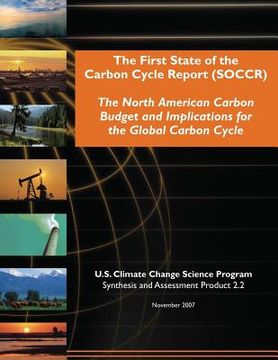The First State of the Carbon Cycle Report (SOCCR): The North American Carbon Budget and Implications for the Global Carbon Cycle (SAP 2.2) (en Inglés)
Reseña del libro "The First State of the Carbon Cycle Report (SOCCR): The North American Carbon Budget and Implications for the Global Carbon Cycle (SAP 2.2) (en Inglés)"
North America is currently a net source of carbon dioxide to the atmosphere, contributing to the global buildup of greenhouse gases in the atmosphere and associated changes in the Earth's climate. In 2003, North America emitted nearly two billion metric tons of carbon to the atmosphere as carbon dioxide. North America's fossil-fuel emissions in 2003 were 27% of global emissions. The combustion of fossil fuels for commercial energy (primarily electricity) is the single largest contributor, accounting for approximately 42% of North American fossil emissions in 2003. Transportation is the second largest, accounting for 31% of total emissions. In 2003, growing vegetation in North America removed approximately 500 million tons of carbon per year ( 50%) from the atmosphere and stored it as plant material and soil organic matter. This land sink is equivalent to approximately 30% of the fossil-fuel emissions from North America. Approximately 50% of North America's terrestrial sink is due to the regrowth of forests in the United States on former agricultural land that was last cultivated decades ago, and on timberland recovering from harvest. The contribution of forest regrowth is expected to decline as the maturing forests grow more slowly and take up less carbon dioxide from the atmosphere. But, how regrowing forests and other sinks will respond to changes in climate and carbon dioxide concentration in the atmosphere is highly uncertain. The large difference between current sources and sinks and the expectation that the difference could become larger if the growth of fossil-fuel emissions continues and land sinks decline suggest that addressing imbalances in the North American carbon budget will likely require actions focused on reducing fossil-fuel emissions. Options to enhance sinks (growing forests or sequestering carbon in agricultural soils) can contribute, but enhancing sinks alone is likely insufficient to deal with either the current or future imbalance. Options to reduce emissions include efficiency improvement, fuel switching, and technologies such as carbon capture and geological storage. Implementing these options will likely require an array of policy instruments at local, regional, national, and international levels, ranging from the encouragement of voluntary actions to economic incentives, tradable emissions permits, and regulations. Meeting the demand for information by decision makers will likely require new modes of research characterized by close collaboration between scientists and carbon management stakeholders. A primary objective of the U.S. Climate Change Science Program (CCSP) is to provide the best possible scientific information to support public discussion, as well as government and private sector decision making, on key climate-related issues. To help meet this objective, the CCSP has identified an initial set of 21 Synthesis and Assessment Products (SAPs) that address its highest priority research, observation, and decision support needs. This report-CCSP SAP 2.2-addresses Goal 2 of the CCSP Strategic Plan: Improve quantification of the forces bringing about changes in the Earth's climate and related systems. The report provides a synthesis and integration of the current knowledge of the North American carbon budget and its context within the global carbon cycle. This report addresses carbon emissions; natural reservoirs and sequestration (absorption and storage); rates of transfer; the consequences of changes in carbon cycling on land and the ocean; effects of purposeful carbon management; effects of agriculture, forestry, and natural resource management on the carbon cycle; and the socio-economic drivers and consequences of changes in the carbon cycle. It covers North America's land, atmosphere, inland waters, and coastal oceans, where "North America" is defined as Canada, the United States of America (excluding Hawaii), and Mexico.

